Ghana, Togo and Benin: Voodoo Festival 2020
12 Days / 11 Nights
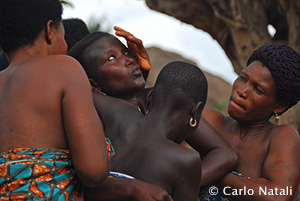
Duration: 12 days
Area: Ghana, Togo, Benin
Style: cultural tours
Comfort Level:![]()
![]()
![]()
![]()
![]()
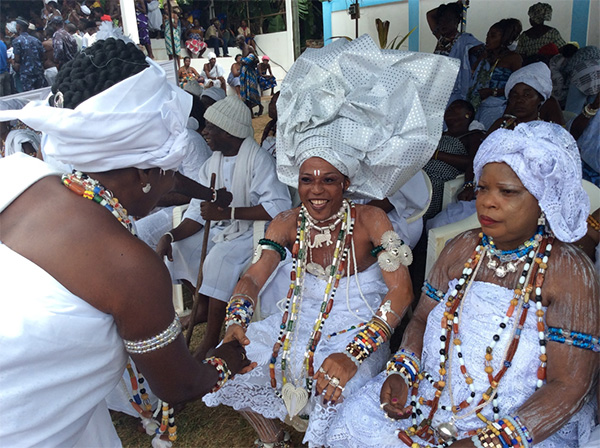
GHANA, TOGO AND BENIN:
VOODOO FESTIVAL
12 Days / 11 Nights
Scheduled departure dates from Lome
2020
January 8th
Minimum 2 - Maximum 16 participants
January 10th is always a very special day in in Benin, a day for celebrating ancestral cults.
In particular all the Voodoo's adepts meet in Ouidah and then convey in a long procession
to the Door of No Return, some on foot while others by motorbike or “taxi-brousse”.
They are all dressed up in traditional costumes, white being the dominant colour.
The Festival reaches its peak with the arrival of the Dagbo Houno, the chief “feticheur”. Dances, libations, masks and some official speeches are all part of the morning programme.
Our fantastic cultural odyssey then heads inland, through northern savannah - we discover the Taneka tribe on a rocky mountain, the Tamberma people with their fairy-tale clay castles and finally we enter the Ashanti kingdom in Kumasi. We end our tour exploring the former Slave Coast, with its haunting European forts.
One of the most complete and spectacular tours in West Africa, and on a very unique occasion.
Great experience combined with the choice of good accommodation.
For travellers who want to get acquainted with this incredible region … and love Africa!
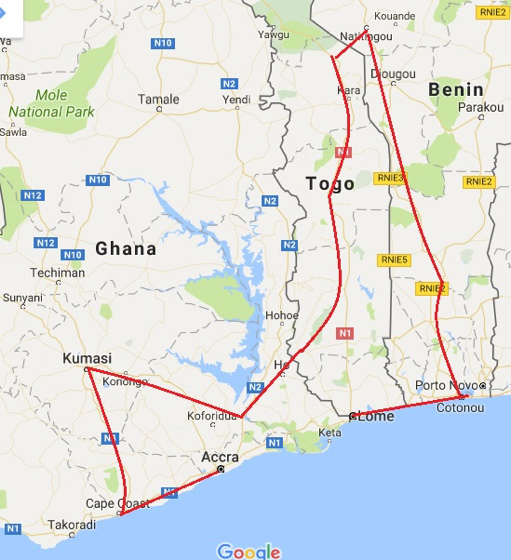
| Day 1 | Lome, Gulf of Guinea - TOGO |
| Day 2 | Fetish market, from Lomé to Ouidah (150 km - 3 hrs)- TOGO & BENIN |
| Day 3 | Voodoo festival, Ouidah - BENIN |
| Day 4 | African Kingdoms, from Ouidah to Dassa (250 km - 5 hr) - BENIN |
| Day 5 | Fetish hills, from Dassa to Natitingou (350 km - 6 hr) - BENIN |
| Day 6 | Fire Dance, from Natitingou to Sokode (180 km - 4 hr) - BENIN & TOGO |
| Day 7 | Rainforest, from Sokode to Kloto (290 km - 5 hr) - TOGO |
| Day 8 | Glass beads, from Kloto to Koforidua (220 km - 5 hr) - TOGO - GHANA |
| Day 9 | Ashanti, from Koforidua to Kumasi (200 km - 5 hr) - GHANA |
| Day 10 | Golden Kingdoms, from Kumasi to Anomabu (250 km - 4 hr) - GHANA |
| Day 11 | Slaves’Castles, from Anomabu to Accra (180 km - 3 hr) - GHANA |
| Day 12 | African metropolis, Accra out - GHANA |
Detailed Itinerary
Day 1: Lome, Gulf of Guinea - TOGO
Arrival in Lome (Togo) and transfer to the hotel.
Meals: free
Overnight: Hotel Onomo (camere con bagno privato e aria condizionata)
Day 2: Fetish market, from Lomé to Ouidah (150 km - 3 hrs) - TOGO & BENIN
Lomé city tour. Lomé, the vibrant capital of Togo, is the only African city which was a colony of the Germans, the British and the French. It is also one of the few capitals in the world bordering with another nation. These elements have led to the development of a unique identity, reflected in the life-style of its inhabitants and in the architecture of the town: Lomé is indeed a cross point for people, trade and cultures, a cosmopolitan city in small size. We will visit: the central market with its famous “Nana Benz”, the women in control of the market of the expensive “pagne” (=cloth) coming from Europe and sold all over West Africa (unfortunately the market has been partially destroyed by fire); the colonial buildings in the administrative quarter where the flavour of colonial time is still very present; and the fetish market where we can find an eclectic assortment of all the necessary ingredients for love potions and magical concoctions.
We later move inland and step into voodoo world. Meeting with a traditional healer - traditional healers treat their patients combining voodoo rites with their deep knowledge of ancestral herbs. Treatments are believed to be effective for almost all diseases, especially for insanity. The endless list of voodoos shows the endless powers concentrated in their impressive shrines!
Meals: B - L - D
Overnight: Hotel Djegba or similar (camere con bagno privato e aria condizionata)
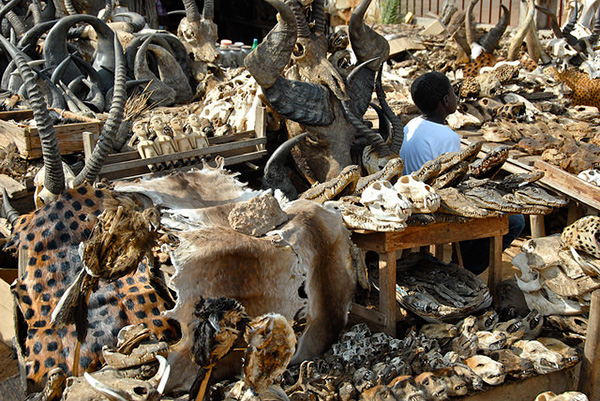
Day 3: Voodoo festival, Ouidah - BENIN
Every 10th of January is a national celebration day in Benin, honouring traditional religion and all cults associated with it. Ouidah in particular is where dozens of voodoo ceremonies are held, calling thousands of adepts, traditional chiefs and fetish priests.
Ouidah was conquered by the Dahomey army during the XVIII century to become one of the main slave ports. Today the town enjoys an Afro-Portuguese architecture, and the python temple faces the Catholic Cathedral. The laid back attitude of the locals blends in harmoniously with the thunder of the distant waves and the rhythm of the drums - a timeless atmosphere very well described by Bruce Chatwin in his book "The Vice-Roy of Ouidah". On foot we visit the Python Temple and the Portuguese Fort, now a museum on the history of Ouidah and on the slave trade. We then end our city tour by following the “slave road” to the beach, the point of “no return” where slaves used to board ships.
As per the program of festivities, we will choose the best sites - the festival takes place in the entire region around Ouidah.
Meals: B - L - D
Overnight: Hotel Djegba or similar (camere con bagno privato e aria condizionata)

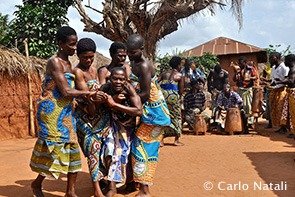
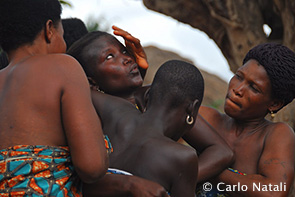
Day 4: African Kingdoms, from Ouidah to Dassa (250 km - 5 hr) - BENIN
We cross Lake Nokwe with a motorized boat and reach Ganvié, the largest and most beautiful African village on stilts. The approximately 25,000 inhabitants of the Tofinou ethnic group build their huts on teak stilts and cover the roofs with a thick layer of leaves. Fishing is their main activity. The village has managed to preserve its traditions and environment despite the long-lasting human presence in a closed setting; and the lake is not over-fished. Life unfolds each day around the canoes that all people manoeuvre with ease using brightly colored poles: men fish, women deliver goods to the market and children go to school and play.
We then move to Abomey where we visit the Royal Palace - its walls decorated with bas-reliefs representing symbols of the ancient Dahomey kings. Now a museum listed on the Unesco World Heritage List, the palace displays items belonging to the ancient rulers: thrones, cult altars, statues, costumes and weapons. The Kingdom economy was for a long time based on the slave trade: a permanent state of war made it possible for the kings to capture thousands of prisoners whom they then sold as slaves. The royal army included a female troop famous for its boldness and aggressive fighting spirit. At the height of their power there were up to 4.000 women in the palace harem. In the middle of the royal courtyard there is a temple built with a mixture of clay, gold dust and human blood. A walk around the buildings helps the visitor to recall the past splendour of the court, a court who also proudly challenged the powerful armies coming to colonize the continent.
Meals: B - L - D
Overnight: Hotel Jeko or similar (camere con bagno privato e aria condizionata)

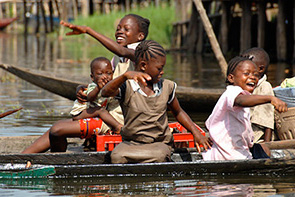

Day 5: Fetish hills, from Dassa to Natitingou (350 km - 6 hr) - BENIN
We stop at the Dankoli Fetish, an important place for the Voodoo cult: thousands of little sticks are pushed in the fetish as testimony of the countless prayers for a good harvest, a happy wedding, an easy delivery, success at school etc. Once the prayers are answered, people come back to sacrifice what they had promised - a goat, a chicken or a cow, according to the nature of the prayer. Traces of blood, palm alcohol or oil on the fetish are proof that many prayers have been answered.
In the afternoon, we discover old Taneka villages located on a mountain of the same name. The villages are made up of round houses, covered with a conical roof protected, at the top, by a terra cotta pot. The upper part of the village is inhabited by the young initiated and by the fetish priests who only cover themselves with a goat skin and always carry a long pipe. This tribe has been living on an archaeological site for centuries, in fact it looks as if the first inhabitants (from Kabye origins) moved to the mountain during the IX century. Since then, other populations have joined thus forming a kind of melting-pot where, despite the fact that each group kept its own cults and initiation rites, common religious and political institutions have been defined. As we wander along alleys bordered by smooth stones, we may come across half naked men. The Taneka people believe that in order to “become” a man, it is necessary to combine time, patience and a lot of… blood from sacrificed animals. It actually is a lifetime process in the sense that life itself becomes a rite of passage, therefore life should not be conditioned by a “before” and an “after” but rather it follows a continuous path.
Meals: B - L - D
Overnight: Hotel Tata Somba or similar (camere con bagno privato e aria condizionata)

Day 6: Fire Dance, from Natitingou to Sokode (180 km - 4 hr) - BENIN & TOGO
We enter the land of Somba & Tamberma who live in adobe fortified dwellings. The shape is like small medieval castles, they are one of the most beautiful examples of traditional African architecture. Their style impressed Le Corbusier vanguard architect that describe it as sculptural architecture. In fact, the houses are built by hand, layer of clay after layer, adding round mud balls and shaping them as per the plan of the house. A kind of sensual gesture mixing strength, care and beauty. Large shrines- of phallic form - at the entrance of their homes show their animistic believes. With the permission granted to us by the elders we enter their homes to better understand their way of life. Actually their houses are projections of their cosmology - the ground floor, with its darkness, represents death and is the place of the ancestors; the second floor, open to the sky, represents life and is the place where grandmothers keep babies until they “find out” which ancestor has come back as the new life - only then the baby will be allowed to come down from the terrace. All - family, food supplies and stock - are kept inside the fortified house, for safety reasons in case of attack by enemies. For centuries these populations have been seeking refuge on the Atakora Mountains to escape Muslim slave traders coming from the north.
Togo border
In the evening, we arrive at the villages of Tem tribe to discover the fire dance. At the centre of the village a large fire lights up the silhouette of the participants. They dance to the hypnotic beat of the drums eventually leaping into the glowing embers, picking up burning coals, passing them over their bodies and even putting them in their mouths and swallowing them. all this without hurting themselves or showing any sign of pain. It’s difficult to explain such a performance. Is it matter of courage? Self-suggestion? Magic? Maybe it really is the fetishes that protect them from the fire.
Meals: B - L - D
Overnight: Hotel Central or similar (all rooms ensuite and with aircon)
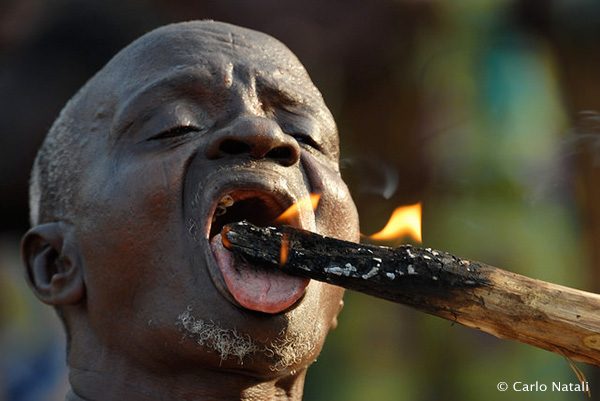
Day 7: Rainforest, from Sokode to Kloto (290 km - 5 hr) - TOGO
We will head southwards, with a stop on the way in Atakpame, a typical African town built on a hill where it is possible to find all the products coming from the nearby forests. Through their skilled work on small weaving looms, the men of the region make the large brightly coloured fabric called “Kente”.
From Atakpame we then move to the tropical forests surrounding Kpalime, a town with a rich colonial past which is now an important trading center. Visit of the market and of the arts center.
A walk in the forest to discover the mysterious world of the tropical forest and meet with the majesty of the tropical trees, the sounds of tam-tam... Under the guidance of a local entomologist, we will learn about endemic butterflies and insects.
Meals: B - L - D
Overnight: Hotel Gess or similar (camere con bagno privato e aria condizionata)
Day 8: Glass beads, from Kloto to Koforidua (220 km - 5 hr) - TOGO - GHANA
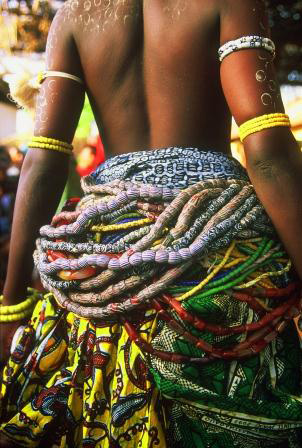 Ghana border crossing and continuation to the Volta Region.
Ghana border crossing and continuation to the Volta Region.
The area of Krobo is famous all around the world for its beads. Here they are produced and used for cults and aesthetic purposes. We will visit a factory specialized in the production of those beads and even follow the process of making one! The craftsmen have been making beads following the same long lasting traditional technique for centuries. They use scrap glass that is grounded into a fine powder. The glass powder is then meticulously made into patterns and placed into hand-made clay moulds covered in kaolin. The beads are cooked then decorated, washed and eventually strung.
We reach Koforidua.
Meals: B - L - D
Overnight: New Capital View or similar (camere con bagno privato e aria condizionata)
Day 9: Ashanti, from Koforidua to Kumasi (200 km - 5 hr) - GHANA
 Kumasi is the historical and spiritual capital of the old Ashanti Kingdom. The Ashanti people were one of the most powerful nations in Africa until the end of the XIX century, when the British annexed Ashanti Country to their Gold Coast colony. The tribute paid today to the Asantehene (=King) is the best evidence of their past splendour and strength. With nearly one million inhabitants, Kumasi is a sprawling city with a fantastic central market, one of the biggest in Africa. Every type of Ashanti craft (leather goods, pottery, Kente cloth) is found here, along with just about every kind of tropical fruit and vegetable.
Kumasi is the historical and spiritual capital of the old Ashanti Kingdom. The Ashanti people were one of the most powerful nations in Africa until the end of the XIX century, when the British annexed Ashanti Country to their Gold Coast colony. The tribute paid today to the Asantehene (=King) is the best evidence of their past splendour and strength. With nearly one million inhabitants, Kumasi is a sprawling city with a fantastic central market, one of the biggest in Africa. Every type of Ashanti craft (leather goods, pottery, Kente cloth) is found here, along with just about every kind of tropical fruit and vegetable.
The program includes a visit to the Ashanti Cultural Centre: a rich collection of Ashanti artefacts housed in a wonderful reproduction of an Ashanti house. In the afternoon, we participate - if available - in a traditional Ashanti funeral, attended by mourners wearing beautiful red or black togas. We say “funeral” but here it actually means a “festive” celebration: the deceased is believed to be still with his/her family and through this ceremony he/she becomes an ancestor. Relatives and friends gather, socialize and celebrate his/her memory. The chief arrives surrounded by his court, under the shade of large umbrellas, while drums give rhythm to the dancers whose intricate moves are highly symbolic.
Optional, we enjoy live music in town.
Meals: B - L - D
Overnight: Miklin Hotel or similar (camere con bagno privato e aria condizionata)
Day 10: Golden Kingdoms, from Kumasi to Anomabu (250 km - 4 hr) - GHANA
In the morning continuation of the tour of Kumasi, with the visit of the Royal Palace Museum hosting a unique collection of gold jewels worn by the Ashanti court.
In the afternoon drive to the coast.
Meals: B - L - D
Overnight: Anomabu Beach Resort or similar (camere con bagno privato e aria condizionata)
Day 11: Slaves’Castles, from Anomabu to Accra (180 km - 3 hr) - GHANA
We start our day with the visit of Elmina Castle, the oldest European building in Africa, erected by the Portuguese in the XV century. At different times the castle has been used as a warehouse to trade gold, ivory, and eventually slaves. The castle we visit today is the result of successive extension works and is recognized as a UNESCO World Heritage site. The old Dutch Cemetery in Elmina goes back to 1806. Outside the castle, a wonderful fishing village with lots of large colorful fishing boats - every day these canoes are guided by skilled fishermen across strong ocean waves and currents, “fighting” to earn a living. In the old town we will see the Posuban, the shrines of the old “Asafo companies” - the warriors who used to put their offerings on the large colorful statues. The alleys in the old town have a very lively atmosphere, bringing us back to a time when Elmina was a busy colonial town.
Drive to Accra.
Optional, we enjoy live music in town.
Meals: B - L - D
Overnight: La Villa Boutique or similar (camere con bagno privato e aria condizionata)
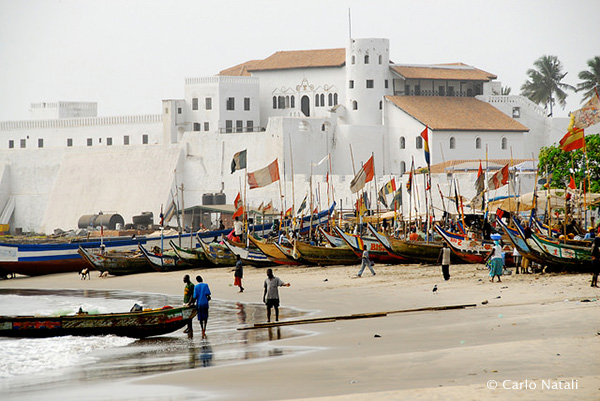
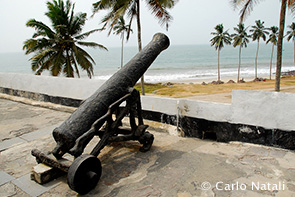
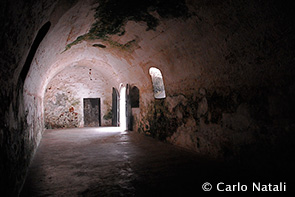
Day 12: African metropolis, Accra out - GHANA
Accra, the capital of Ghana, has maintained its unique identity despite the fast paced development currently underway in this intriguing African city. The program includes a visit to the National Museum, (if open, now under renovation), one of the first works of independent Ghana - the idea inspiring the Museum is to relate Ghanaian art to the rest of the continent and to prove the existence of an African history as part of the general history of humanity. We explore the old quarter of James Town, inhabited by the local population known as the Ga. Our day tour ends with the visit of a workshop specialized in building fantasy coffins. These special handcrafted coffins can reflect any shape: fruits, animals, fish, cars, airplanes…. the only limit being imagination! Started in Africa, these flamboyant coffin designs are by now collected worldwide and exposed in museums.
In the evening transfer to the airport for the flight out.
Meals: B - L
Day-use: Rooms in day-use till 18.00 hrs (camere con bagno privato e aria condizionata)
Day 1: Hotel Onomo, |
 |
Day 2 - 3: Hotel Djegba, |
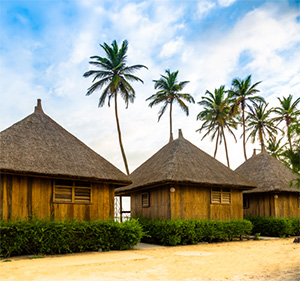 |
Day 4: Hotel Jeko or similar, |
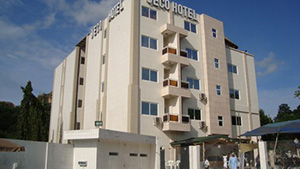 |
Day 5: Hotel Tata Somba or similar, |
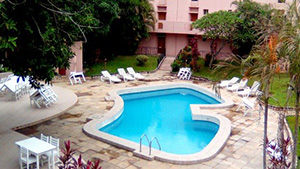 |
Day 6: Hotel Central or similar, |
|
Day 7: Hotel Gess or similar, |
 |
Day 8: New Capital View Hotel or similar, |
|
Day 9: Miklin Hotel or similar, |
 |
Day 10: Anomabu Beach Resort or similar, |
 |
Day 11: La Villa Boutique or similar, |
 |




